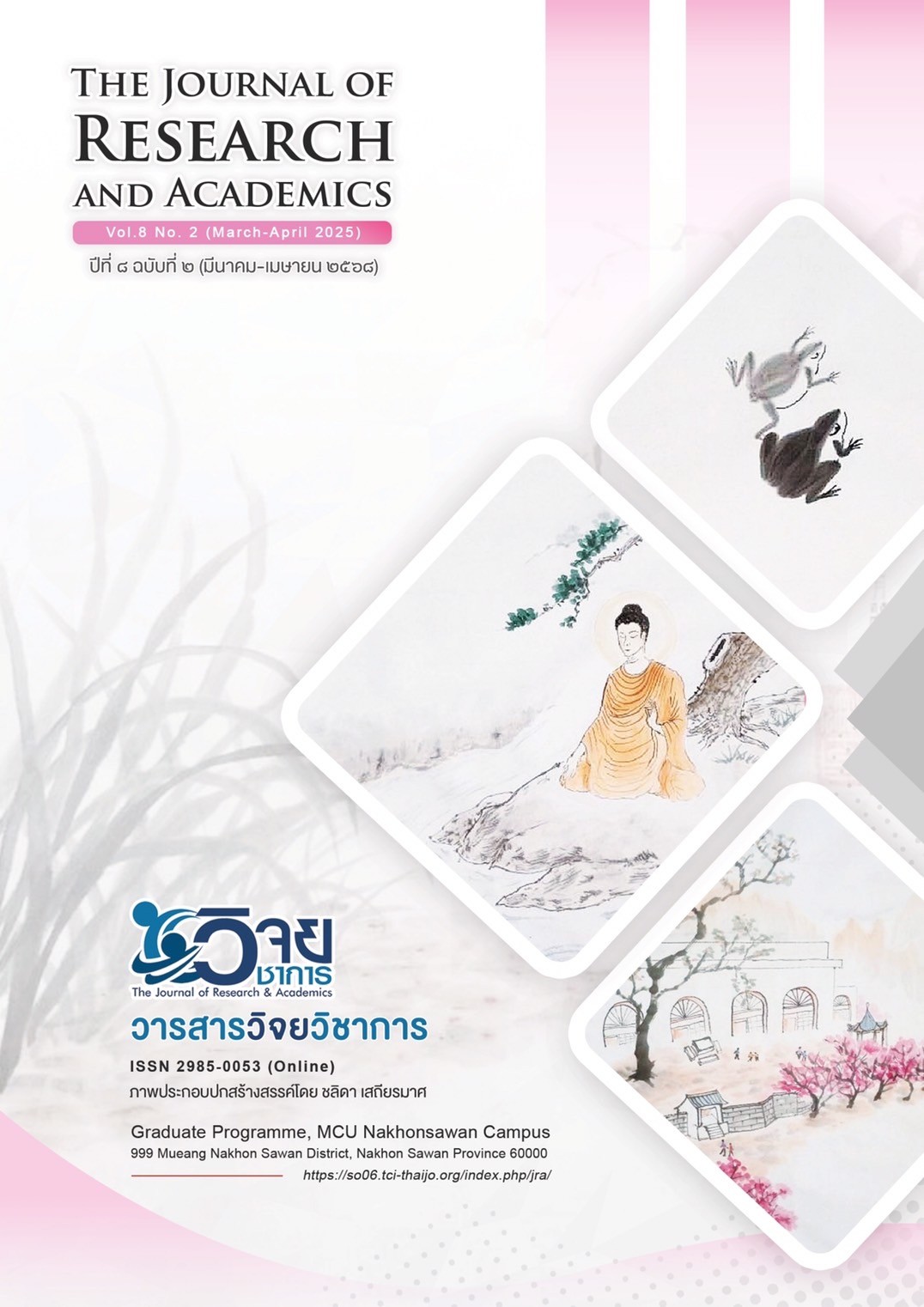Academic Cooperation Network Management Model of School Administrators under Primary Educational Service Area Office based on Saraniyadhamma 6
Main Article Content
Abstract
The objectives of this research article were 1) to study the components of academic cooperation network management of school administrators under the Primary Educational Service Area Office; 2) to create a model of academic cooperation network management of school administrators under the Primary Educational Service Area Office based on Saraniyadhamma 6; and 3) to evaluate the model of academic cooperation network management of school administrators under the Primary Educational Service Area Office on Saraniyadhamma 6. This was a mixed methods research, using content analysis and interviews with 18 key informants, focus group discussions with 9 experts, and model evaluations with 16 people, using an evaluation form. Data were analyzed using mean and standard deviation. The research results found that 1) the components of academic cooperation network management of school administrators under the Primary Educational Service Area Office consisted of 1.1) in the stage of realizing the need to create a network, school administrators should create awareness for everyone to see the mutual benefits, 1.2) in the stage of coordinating network agencies/organizations, school administrators should use two-way communication and organize activities for members to do together, 1.3) in the stage of creating a joint agreement, school administrators should operate the network with goals, objectives and mutual agreements, 1.4) in the network management stage, school administrators should appoint a network management committee, organize the structure, determine roles and responsibilities, and establish joint rules and regulations, 1.5) in the stage of developing relationships, school administrators should organize activities for members to have opportunities to interact with each other, 1.6) in the relationship maintenance stage, school administrators should create professional learning communities, build morale, and honor members; 2) the results of creating academic cooperation network management models of school administrators under the Primary Educational Service Area Office based on Saraniyadhamma 6 found that there were a total of 24 models; 3) the results of evaluating academic cooperation network management models of school administrators under the Primary Educational Service Area Office based on Saraniyadhamma 6 found that the accuracy, appropriateness, feasibility of implementation and benefits were at the highest level.
Article Details

This work is licensed under a Creative Commons Attribution-NonCommercial-NoDerivatives 4.0 International License.
1. เนื้อหาและข้อมูลในบทความที่ลงพิมพ์กับวารสารวิจยวิชาการ ถือเป็นข้อคิดเห็น และความรับผิดชอบของผู้เขียนบทความโดยตรงซึ่งกองบรรณาธิการวารสารไม่จำเป็นต้องเห็นด้วย หรือร่วมรับผิดชอบใด ๆ
2. บทความ ข้อมูล เนื้อหา รูปภาพ ฯลฯ ที่ได้รับการตีพิมพ์ในวารสารวิจยวิชาการ ถือเป็นลิขสิทธิ์ของวารสารวิจยวิชาการ หากบุคคลหรือหน่วยงานใดต้องการนำทั้งหมดหรือส่วนหนึ่ง ส่วนใดไปเผยแพร่ต่อหรือเพื่อการกระทำการใด ๆ จะต้องได้รับอนุญาตเป็นลายลักษณ์อักษรจากวารสารวิจยวิชาการก่อนเท่านั้น
References
กระทรวงศึกษาธิการ. (2546). พระราชบัญญัติการศึกษาแห่งชาติ พ.ศ. 2542 และที่แก้ไขเพิ่มเติม (ฉบับที่ 2) พ.ศ. 2545. กรุงเทพฯ : กระทรวงศึกษาธิการ.
กาญจนา พิมพ์สุข. (2555). การประยุกต์ใช้หลักสาราณียธรรม 6 ในการบริหารสถานศึกษา ของผู้บริหารสถานศึกษาสังกัดสำนักงานเขตพื้นที่การศึกษาประถมศึกษาขอนแก่น เขต 1. (ดุษฎีนิพนธ์พุทธศาสตรดุษฎีบัณฑิต สาขาวิชาการบริหารการศึกษา). บัณฑิตวิทยาลัย : มหาวิทยาลัยมหาจุฬาลงกรณราชวิทยาลัย.
ขจรวรรณ ภู่ขจร. (2564). รูปแบบเครือข่ายความร่วมมือระหว่างองค์กรเพื่อส่งเสริมการจัดการเรียนกาสอนภาษาจีนในโรงเรียนเอกชน. (วิทยานิพนธ์การศึกษาดุษฎีบัณฑิต สาขาวิชาการบริหารการศึกษา). บัณฑิตวิทยาลัย : มหาวิทยาลัยนเรศวร.
ขนิฏฐา กาญจนรังสีนนท์. (2566). เครือข่ายเพื่อการพัฒนา. เข้าถึงได้จาก https://asapake. tripod.com/k10.htm.
ธนานนท์ แสงทองทาบ และคณะ. (2565). การสร้างมนุษยสัมพันธ์ของผู้บริหารกับชุมชน ตามหลักสาราณียธรรม 6 ของโรงเรียนขยายโอกาสทางการศึกษา อำเภอหนองบัว จังหวัดนครสวรรค์. วารสารวิจยวิชาการ, 1(3), 117-130.
ธีระชัย ช่วงบุญศรี. (2558). การพัฒนารูปแบบการบริหารเครือข่ายความร่วมมือทางวิชาการของโรงเรียนวิทยาศาสตร์ภูมิภาค. (วิทยานิพนธ์การศึกษาดุษฎีบัณฑิต สาขาวิชาการบริหารการศึกษา). บัณฑิตวิทยาลัย : มหาวิทยาลัยนเรศวร.
ประยูร อัครบวร และคณะ. (2553). การสร้างเครือข่ายและการมีส่วนร่วม. กรุงเทพฯ : สำนักพิมพ์แห่งจุฬาลงกรณ์มหาวิทยาลัย.
พระธวัชชัย ชยวุฑฺโฒ (ไชยวุฒิ). (2564). รูปแบบองค์กรแห่งความสุขตามหลักสาราณียธรรมของวิทยาลัยสงฆ์ลำพูน. (ดุษฎีนิพนธ์พุทธศาสตรดุษฎีบัณฑิต สาขาวิชาพระพุทธศาสนา) บัณฑิตวิทยาลัย : มหาวิทยาลัยมหาจุฬาลงกรณราชวิทยาลัย วิทยาเขตเชียงใหม่.
พระมหากฤษดา สิริวฑฺฒโน. (2565). การบริหารสถานศึกษาตามหลักสาราณียธรรม 6 ของโรงเรียนพระปริยัติธรรมศรีจันทร์วิทยา แผนกสามัญศึกษา. วารสารสังคมศาสตร์บูรณาการ, 2(5), 25-32.
ไพรสณฑ์ มะโนยานะ. (2556). คู่มือการใช้รูปแบบเครือข่ายกลุ่มโรงเรียนเพื่อพัฒนาคุณภาพการจัดการศึกษาของโรงเรียนในสังกัดสำนักงานเขตพื้นที่การศึกษาประถมศึกษาแพร่ เขต 2. แพร่ : สำนักงานเขตพื้นที่การศึกษาประถมศึกษาแพร่ เขต 2.
ภัทรพล คำผาลา. (2566). แนวทางการบริหารงานบุคคลตามหลักสาราณียธรรม 6 ของผู้บริหารสถานศึกษาสังกัดองค์การบริหารส่วนจังหวัดร้อยเอ็ด. วารสารการบริหารการศึกษา มมร.วิทยาเขตร้อยเอ็ด, 3(3), 27-36.
ภัทรวรรธน์ นิลแก้วบวรวิชญ์. (2559). รูปแบบการพัฒนาเครือข่ายความร่วมมือทางวิชาการของสำนักงานเขตพื้นที่การศึกษาประถมศึกษา สังกัดสำนักงานคณะกรรมการการศึกษาขั้นพื้นฐาน. (ดุษฎีนิพนธ์การศึกษาดุษฎีบัณฑิต สาขาวิชาการบริหารการศึกษา). บัณฑิตวิทยาลัย : มหาวิทยาลัยบูรพา.
ศิริพงษ์ อรุณเดชาชัย. (2559). สถานีสาราณียธรรม: พื้นที่บ่มเพาะความรู้ชุมชน กรณีศึกษาชุมชนบ้านแฮด ตำบลบ้านแฮด จังหวัดขอนแก่น. (ดุษฎีนิพนธ์ปรัชญาดุษฎีบัณฑิต สาขาวิชานวัตกรรมเพื่อการพัฒนาท้องถิ่น). บัณฑิตวิทยาลัย : มหาวิทยาลัยราชภัฏมหาสารคาม.
สำนักงานเลขาธิการวุฒิสภา ปฏิบัติหน้าที่สำนักงานเลขาธิการสภานิติบัญญัติแห่งชาติ. (2560). รัฐธรรมนูญแห่งราชอาณาจักรไทย พุทธศักราช 2560. (พิมพ์ครั้งที่ 3). กรุงเทพฯ : สำนักงานเลขาธิการวุฒิสภา.
อุดมสิน คันธภูมิ. (2558). การพัฒนารูปแบบเครือข่ายความร่วมมือในการพัฒนาคุณภาพผู้เรียนสำหรับโรงเรียนประถมศึกษา สังกัดสำนักงานเขตพื้นที่การศึกษาประถมศึกษา. (วิทยานิพนธ์การศึกษาดุษฎีบัณฑิต สาขาวิชาการบริหารและการพัฒนาการศึกษา). บัณฑิตวิทยาลัย : มหาวิทยาลัยมหาสารคาม.

